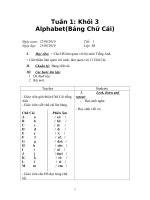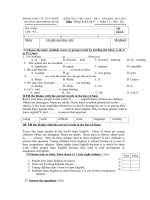Professional practice ASSIGNMENT 2 unit 3 professional practice
Bạn đang xem bản rút gọn của tài liệu. Xem và tải ngay bản đầy đủ của tài liệu tại đây (1.06 MB, 32 trang )
Professional Practice
ASSIGNMENT 2
Teacher: Ngo Ngoc Tri
Student Name: Tran Quang Huy
Class: GCD0825
TIEU LUAN MOI download :
ASSIGNMENT 2 FRONT SHEET
Qualification
Unit number and title
Submission date
Re-submission Date
Student Name
Class
Student declaration
I certify that the assignment submission is entirely my own work and I fully understand the consequences of plagiarism. I
understand that making a false declaration is a form of malpractice.
Student’s signature
HUY
Grading grid
P7
P8
M5
D4
TIEU LUAN MOI download :
Summative Feedback:
Grade:
Resubmission Feedback:
Assessor Signature:
Date:
Internal Verifier’s Comments:
Signature & Date:
TIEU LUAN MOI download :
Contents
Examine the need for Continuing Professional Development (CPD) and its
role within the workplace and for higher level learning........................................... 1
1. Discuss the importance of CPD and its contribution to own learning.............................. 1
2.
Produce a development plan that outlines responsibilities, Performance objectives
and
required skills, knowledge and learning for own future goals.............................................. 7
3.
Compare and contrast different motivational theories and the impact they can have
on
performance within the workplace..................................................................................... 15
4. Evaluate a range of evidence criteria that is used as a measure for effective CPD........ 17
CONCLUSION.................................................................................................................... 21
References........................................................................................................................... 22
TIEU LUAN MOI download :
TABLE OF TABLES
Table 1 - Action plan............................................................................................................... 14
Table 2 - My AXELOS CPD Table. (axelos, n.d.)........................................................................ 17
Table 3 - Evaluate the criteria effective CPD.............................................................................. 19
TABLE OF FIGURES
Figure 1 - Continuing Professional Development. (axelos, n.d.)..................................................... 2
Figure 2 - SWOT evaluation...................................................................................................... 7
Figure 3 - Smart Goals. (myfitnesspal, n.d.)............................................................................... 10
Figure 4 - My motivational behavior report................................................................................. 15
Figure 5 - My behavioral Approach........................................................................................... 15
Figure 6 - My behavioral Inhibition........................................................................................... 16
TABLE OF PICTURES
Picture 1 - My personality style.................................................................................................. 8
Picture 2 - My Personality traits................................................................................................. 8
TIEU LUAN MOI download :
INTRODUCTION
I will examine different methods of learning and reflection, which will help them to identify their own
preferred style of learning. They will use this information as a basis for writing an essay about
learning styles, self-managed learning, the role of lifelong learning, personality reflection and,
aspects of time management and also compile a personal portfolio of information about themselves,
which will help them to identify and achieve their personal goals. You will be assessed on the quality
of the information provided in this assignment. You should identify the above issues clearly and
present professionally in a report format. My evaluation should be ‘SMART’ than a mere description.
I will analyse qualities of existing business entrepreneurs for you to carry out the self-evaluation.
TIEU LUAN MOI download :
Examine the need for Continuing Professional
Development (CPD) and its role within the
workplace and for higher level learning
1. Discuss the importance of CPD and its contribution to own learning.
1.1.
What is Continuing Professional Development.
CPD stands for Continuing Professional Development. It refers to the process of tracking and
documenting the skills, knowledge and experience that you gain both formally and informally as
you work, beyond any initial training. It's a record of what you experience, learn and then apply.
The term is generally used to mean a physical folder or portfolio documenting your development
as a professional. Some organizations use it to mean a training or development plan, which I
would argue is not strictly accurate. This article is about CPD as a process of recording and
reflecting on learning and development. (jobs, n.d.)
What is it for?
The CPD process helps you manage your own development on an ongoing basis. It's function is
to help you record, review and reflect on what you learn. It's not a tick-box document recording
the training you have completed. It's broader than that.
The key features of the CPD process:
To justify the name, a CPD needs to:
-
Be a documented process
-
Be self-directed: driven by you, not your employee
-
Focus on learning from experience, reflective learning and review
-
Help you set development goals and objectives
-
Include both formal and informal learning.
1|Page
TIEU LUAN MOI download :
What will it do for you?
A CPD may be a requirement of membership of a professional body. It can help you to reflect,
review and document your learning and to develop and update your professional knowledge and
skills. It is also very useful to:
-
Provides an overview of your professional development to date
-
Reminds you of your achievements and how far you've progressed
-
Directs your career and helps you keep your eye on your goals
-
Uncovers gaps in your skills and capabilities
-
Opens further development needs
-
Provides examples and scenarios for a CV or interview
-
Demonstrates your professional standing to clients and employers
-
Helps you with your career development or a possible career change.
Figure 1 - Continuing Professional Development. (axelos, n.d.)
2|Page
TIEU LUAN MOI download :
1.2.
The importance of CPD.
Continuing Professional Development exists to ensure that an individual enhances their skills
and abilities once they have formally qualified. Typically, academic qualifications have already
been completed at this stage and an individual is now working within their specific industry and
job function. CPD is important as it helps to ensure that further learning is progressed in a
structured, practical and relevant way to guarantee that there are applied efficiencies in learning.
CPD allows an individual to focus on what specific skills and knowledge they require over a
short-term period, say 12 months, in order to be confident there is recognizable improvement
within their proficiency and skill sets. (cpduk, n.d.)
The purpose of CPD
In an ever-increasing globalized and competitive society, the importance of Continuing
Professional Development cannot be overstated. The world’s industries are forever evolving,
which creates exciting opportunities, but which also comes with challenges. CPD enables an
individual to regularly apply attention to important areas of development and takes appropriate
action to reduce any shortfalls in knowledge. Equally, an individual must see Continuing
Professional Development to remain competitive with his or her peers, and as an opportunity to
differentiate themselves at moments where this may be required, such as in job interviews or in
tenders for new work and business acquisition. As more people become professionally qualified
with similar qualifications, CPD becomes more important as a means of separating yourself from
the pack.
A planned approach to Continuing Professional Development allows an individual to put
themselves in charge of their own career development and work-related ambitions. A personal
empowerment of learning brings with it an increase in confidence and resulting abilities, all of
which correlate to an improvement of capability for their employment environment.
3|Page
TIEU LUAN MOI download :
1.3.
How CPD contribution to own learning?
We have devised a three-stage cycle you can follow easily to meet your annual points
requirements:
-
Step 1: Assess capability and plan learning
Assess your skills and capabilities to help you understand your development needs so you can
identify the right activities and measure your progress against these.
-
Step 2: Acquire skills and knowledge
Once you understand your development goals, you can go out and undertake activities to help
you meet them. Your development is about you and so it is in your power to choose the activities
that are relevant to your goals.
-
Step 3: Apply and evaluate
This final stage of the cycle focuses on the outcome of your activity and how it has helped you
meet your development goals. When you log your activity, you will be asked to evaluate the
outcome either by providing a description of your learning or by selecting the skills you have
developed. (axelos, n.d.)
How do I start?
Keep a learning log and record your thoughts in whatever way suits you best. You may find it
helpful to write things down in detail, for example, or to make notes on insights and learning
points. The process of writing makes you think about your experiences at the time and makes
planning and reflection much easier. You can't review your experiences without recording them,
however good your memory is.
4|Page
TIEU LUAN MOI download :
Answering the following questions may help to know how CPD contribution to own learning:
Where am I now?
Review and reflect on any learning experiences over the previous year or over the past three
months. Write your thoughts down about what you learned, what insights it gave you and what
you might have done differently. Include both formal training events and informal learning, such
as:
-
learning from colleagues or shared learning from networking
-
reading about new technologies, new methods of working, legislative changes
-
shadowing or assisting an experienced colleague
-
insights and learning points from coaching and mentoring
-
reflections, insights and learning points from taking on a new responsibility
-
organizational or role change
-
temporary job swaps within the department/organization
-
deputizing or covering for colleagues
-
insights and lessons learned from mistakes
-
lessons learned from critical incidents or events
Make a note of any outcomes of each learning experience and what difference it has made to
you, your colleagues, your students (if relevant) or your employer.
Where do I want
to be?
Write down your overall career goals - where you want to be in two, five- and 10-years’ time.
Then write down no more than three specific and achievable shorter-term objectives, including
the dates by which you want to achieve them.
What do I have to do to get there?
Looking at your overall career goals, make a note of what you need to do to achieve them. This
could include further training, job or role progression or changes in direction.
For shorter term objectives, include the first step - what you can do today or tomorrow. For
example, having a chat with your manager about a new responsibility or finding out about new
technology from a colleague who has experience of it.
5|Page
TIEU LUAN MOI download :
When should I review progress?
This step is essential! You'll need to set a date in advance for review of the objectives you've set
yourself. You can either do this from one review to the next or decide to review regularly - once
every three, six or 12 months. Put it in your diary and do it! The cycle of continuing professional
development has begun. (jobs, n.d.)
6|Page
TIEU LUAN MOI download :
2.
Produce a development plan that outlines responsibilities,
Performance objectives and required skills, knowledge and learning for
own future goals.
2.1.
Personal analysis.
2.1.1. SWOT evaluation
•Knowledge of economics
•Team leadership skills
•Skills to organize event/programs
•Music instruments
knowledge: Piano
•Creative
•Self-learning skill
•Leader of IoT Club
•Have a relationship with technology
experts
•Access to many new technologies
•Easy to distract
•English is not good
•Overthink things.
S
W
O
T
•Meet many jobs at the
same time
•Lack of technology knowledge
Figure 2 - SWOT evaluation
7|Page
TIEU LUAN MOI download :
2.1.2. What is my personality style?
Base on: , I realize that my personality style is Protagonist –
ENFJ-T ( />
Picture 1 - My personality style
Picture 2 - My Personality traits
8|Page
TIEU LUAN MOI download :
-
Protagonists are natural-born leaders, full of passion and charisma. Forming
around two percent of the population, they are oftentimes our politicians, our coaches and
our teachers, reaching out and inspiring others to achieve and to do good in the world.
With a natural confidence that begets influence, Protagonists take a great deal of pride
and joy in guiding others to work together to improve themselves and their community.
-
The interest Protagonists have in others is genuine, almost to a fault – when
they believe in someone, they can become too involved in the other person’s problems,
place too much trust in them. Luckily, this trust tends to be a self-fulfilling prophecy, as
Protagonists’ altruism and authenticity inspire those, they care about to become better
themselves. But if they aren’t careful, they can overextend their optimism, sometimes
pushing others further than they’re ready or willing to go.
-
Few personality types are as inspiring and charismatic as Protagonists. Their
idealism and vision allow Protagonists to overcome many challenging obstacles, often
brightening the lives of those around them. Protagonists’ imagination is invaluable in
many areas, including their own personal growth.
-
Yet Protagonists can be easily tripped up in areas where idealism and altruism
are more of a liability than an asset. Whether it is finding (or keeping) a partner, staying
calm under pressure, reaching dazzling heights on the career ladder or making difficult
decisions, Protagonists need to put in a conscious effort to develop their weaker traits and
additional skills.
-
As in the team-leader role, I always prefer to establish real friendships and use
my broad popularity to inspire and motivate, taking on the role of leader, working
alongside my subordinates, listen and understand their perspectives, rather than
shouting from behind my desks. I believe that leading style will help to smooth things
over and adapt to the needs of my team.
9|Page
TIEU LUAN MOI download :
2.1.3. S.M.A.R.T Goals
What Does SMART Mean?
SMART is an acronym that you can use to guide your goal setting.
To make sure your goals are clear and reachable, each one should be:
-
Specific (simple, sensible, significant).
-
Measurable (meaningful, motivating).
-
Achievable (agreed, attainable).
-
Relevant (reasonable, realistic and resourced, results-based).
-
Time bound (time-based, time limited, time/cost limited, timely, time-
sensitive). (mindtools, n.d.)
Figure 3 - Smart Goals. (myfitnesspal, n.d.)
10 | P a g e
TIEU LUAN MOI download :
How to Use SMART
-
Specific: My goal should be clear and specific, otherwise I won’t be able to
focus my efforts or feel truly motivated to achieve it.
-
Measurable: It’s important to have measurable goals, so that I can track my
progress and stay motivated. Assessing progress helps me to stay focused, meet my
deadlines and feel the excitement of getting closer to achieving my goal.
-
Achievable: My goal also needs to be realistic and attainable to be
successful. In other words, it should stretch my abilities but still remain possible. When I
set an achievable goal, I may be able to identify previously overlooked opportunities or
resources that can bring me closer to it.
-
Relevant: This step is about ensuring that my goal matters to me and that it
also aligns with other relevant goals. We all need support and assistance in achieving
our goals, but it’s important to retain control over them. So, make sure that my plans
drive everyone forward, but that I am still responsible for achieving my goal.
-
Time-bound: Every goal needs a target date, so that I have a deadline to
focus on and something to work toward. This part of the S.M.A.R.T goal criteria helps
to prevent everyday tasks from taking priority over my longer-term goals.
11 | P a g e
TIEU LUAN MOI download :
2.2.
Goals, objectives and action plan
2.2.1. Goals and objectives
Short team goals (Next 12 months)
-
Achieve the IELTS certificate with the result at least 6.5 point
-
Achieve the CCNA
-
Improve knowledge of IoT, AI, Machine Learning, Deep Learning, Blockchain
-
No absence of any class
-
Top of every class (Major)
Mid-term goals (Next 2 years)
-
Graduate bachelor’s degree of Computing from University of Greenwich
-
Having a scholarship to England.
-
Become a professional in IoT
-
Having a scholarship to study Ph.D. degree in another country
Long-term goals (Beyond 4 years)
-
Successfully graduate Ph.D. degree
-
Have a job in international company.
-
Get married.
-
Have own house and car
12 | P a g e
TIEU LUAN MOI download :
Priority
O
No.
1
Achieve the
IELTS
certificate
with the
result at least
6.5 point
2
Become a
professional
in IoT
13 | P a g e
TIEU LUAN MOI download :
3
Having a
scholarship
to England.
14 | P a g e
TIEU LUAN MOI download :
3. Compare and contrast different motivational theories and the impact
they can have on performance within the workplace.
Base on: , I have undertaken a motivational behavior test and
the results are as follows:
Figure 4 - My motivational behavior report
I have a very strong drive to complete tasks that I have set myself, or that others have set for
me, however I am very motivated by seeking reward for my behavior. The offer of a reward
(such as a promotion for working hard or winning a bet) will keep my motivated to complete
difficult activities.
Figure 5 - My behavioral Approach
I have a very strong drive to complete tasks that I have set myself, or that others have set for
me. I am actively seeking out activities that will make me happy, including parties, hanging out
with family and friends or even thrill seeking through sports etc... I am also tending to be
impulsive.
I am very motivated by seeking reward for my behavior. The offer of a reward (such as a
promotion for working hard or winning a bet) will keep my motivated to complete difficult
activities.
15 | P a g e
TIEU LUAN MOI download :
Figure 6 - My behavioral Inhibition
My major motivation is to avoid things that i don't like. This can mean organising my life to avoid
activities i am not enjoy, or to escape punishment or pain. I can also tend to be a fairly nervous
person.
(seemypersonality, n.d.)
16 | P a g e
TIEU LUAN MOI download :
4. Evaluate a range of evidence criteria that is used as a measure for
effective CPD.
I must complete 20 points' worth of activities linked to the product you registered with within a
12-month period. Five points must come from the Professional Experience category, but the
remaining 15 can be earned from activities across the Training and Qualifications, Community
Participation and Self-study categories.
One point equates to one hour’s worth of effort and I can record a minimum of 30 minutes, or 0.5
points, up to a maximum of 15 hours or 15 points. For Professional Experience, to gain the five
points, I will need to list five activities that you undertake within your role and that link to the skills
and behaviors expected of your role.
I will need to log the activities for Professional Experience and submit those in order to achieve
your first digital badge. I will then have the remainder of your subscription period to achieve an
additional 20 points, to receive a digital badge when I renew.
Table 2 - My AXELOS CPD Table. (axelos, n.d.)
17 | P a g e
TIEU LUAN MOI download :
Evaluate the criteria that affect CPD's effectiveness through future plans:
Criteria
Short- Self-Study
term
goals
Low
Self-Study
Community
Improve knowledge
Participation
of IoT, AI, Machine
High
Learning, Deep
Learning, Blockchain
Self-Study
No absence of any
High
Doing
1
High
Doing
1
class and be top of
every class (Major)
MidTerm
Goals
Self-Study
Graduate bachelor’s
degree of Computing
from University of
Greenwich
Training
Professional
experience
Training
Having a scholarship
to England.
Medium
Become a
High
professional in IoT
Having a scholarship
to study Ph.D degree
in another country
18 | P a g e
Medium









